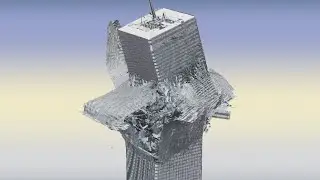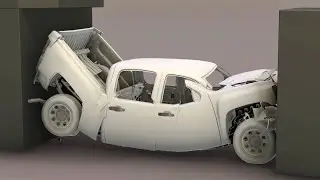Albiano Bridge Collapse Simulation, aka Caprigliola Bridge or Ponte di Albiano Magra | BCB
Simulation of the Caprigliola bridge collapsed in Albiano Magra, Italy, in 2020, performed with the Bullet Constraints Builder (BCB) structural simulation software for Blender. The model was built from plans & photos true to scale. Reinforcement information was estimated in part from photos of the destroyed bridge.
In the morning on the 8th of April 2020, the Albiano bridge in the region of Tuscany collapsed with only two vehicles on the road deck. The original bridge that was built in 1908 pioneered the construction of reinforced concrete bridges in Italy. The Venetian engineer Attilio Muggia designed the bridge with five slender arc structures spanning each ca. 52 m and four Pylons in the riverbed of the Magra river. The Pylons had strong vertical extensions that carried part of the road deck weight.
The bridge was damaged by mines in 1945 during the last days of the second world war. It was reconstructed after the war when building material was scarce, only the base of the pylons was reused. Instead of sufficiently dimensioned arcs, the new bridge design displayed arcs with tapering cross-sections at the bases, which were connected pairwise at opposite sites of each pylon. The tendency of low and wide-spanning arc structures to prolongate at the base was most probably not sufficiently considered, by offering enough resistance against horizontal forces. Furthermore, the debris of the broken arc bases appears to display little reinforcement iron this might be due to the material shortage at the time of the reconstruction. Stronger arc sections at the bases with more iron would have strengthened the structure.
We have simulated this collapse after careful analyzes of the image and video material that was posted online after the accident. This simulation assumes that material fatigue at the base of the second arc at the first Eastern pylon triggered the progressive collapse. This is a hypothesis that might help in the discussion to determine the reason for the collapse.
Our simulation method is based on the Discrete Element Method (DEM) that was developed during the EU funded INACHUS FP7 Project (607522) framework. It uses the open-source “Bullet Constraints Builder” addon for the 3D Blender software.
Details of the bridge:
Material: Reinforced concrete
Total length: 260 m (850 ft)
Width: 7.2 m (24 ft)
Height: 10 m (33 ft)
No. of spans: 5
Pylons: 4
Date of original: 1908
Rebuilt: 1945–1949
Collapsed: April 8, 2020
Credits:
Simulation by Virtual Validation Corporation
Kai Kostack, [email protected]
Dipl. Arch ETH Oliver Walter, [email protected]
Simulated with BCB: https://github.com/KaiKostack/bullet-...
BCB blog: https://inachuslaurea.wordpress.com
This software is developed at the Laurea University of Applied Sciences, Finland. Written within the scope of EU Inachus FP7 Project (607522):
Technological and Methodological Solutions for Integrated Wide Area Situation Awareness and Survivor Localisation to Support Search and Rescue (USaR) Teams
Music: Search and Destroy by Audionautix (CC-BY)




![[2] Umugani w'Ibimanuka byategetse u Rwanda. Ukuri kurimo ni ukuhe? Ibisobanuro bya F. Rudakemwa](https://images.videosashka.com/watch/H38VPFSRC9g)












![WTC Simulation 2.0 Announcement [8K]](https://images.videosashka.com/watch/WbsQrsN3mIU)
![Surfside Collapse Air Pockets Visualization | Champlain Towers Condo Miami Florida [8K]](https://images.videosashka.com/watch/XkwHxVGKQKU)
![Condo Collapse Simulation | Champlain Towers South Surfside, Florida, Miami [8K]](https://images.videosashka.com/watch/HPwJ0JvTcg8)